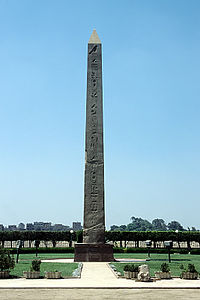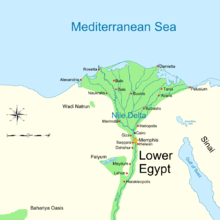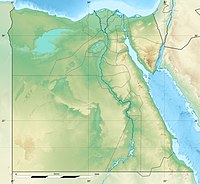Heliopolis (ancient Egypt)
Jwnw or Iunu | |
 Al-Masalla obelisk, the largest surviving monument from Heliopolis, pictured in 2001. | |
| Location | Egypt |
|---|---|
| Region | Cairo Governorate |
| Coordinates | 30°07′46″N 31°18′27″E / 30.129333°N 31.307528°E |
Heliopolis (Jwnw, Iunu; Ancient Egyptian: 𓉺𓏌𓊖, romanized: jwnw, lit. 'the Pillars'; Coptic: ⲱⲛ; Greek: Ἡλιούπολις, romanized: Hēlioúpolis, lit. 'City of the Sun') was a major city of ancient Egypt. It was the capital of the 13th or Heliopolite Nome of Lower Egypt [citation needed] and a major religious centre. Its site is within the boundaries of Ain Shams and El Matareya, districts (kism) in northeastern Cairo.
Heliopolis was one of the oldest cities of ancient Egypt, occupied since prehistoric Egypt.[1] It greatly expanded under the Old and Middle Kingdoms but is today mostly destroyed, its temples and other buildings having been scavenged for the construction of medieval Cairo. Most information about the ancient city comes from surviving records.
The major surviving remnant of Heliopolis is the obelisk of the Temple of Ra-Atum erected by Senusret I of Dynasty XII. It still stands in its original position, now within Al-Masalla in El Matareya, Cairo.[2] The 21 m (69 ft) high red granite obelisk weighs 120 tons (240,000 lbs) and is believed to be the oldest surviving obelisk in the world.[3] Under Augustus, the Romans took the Obelisk of Montecitorio from Heliopolis to Rome, where it remains. The two smaller obelisks called Cleopatra's Needles, in London and New York, also came from the city.
Names
[edit]
| |||
| Heliopolis iwnw[a] in hieroglyphs | |||
|---|---|---|---|
Heliopolis is the Latinised form of the Greek name Hēlioúpolis (Ἡλιούπολις), meaning "City of the Sun". Helios, the personified and deified form of the sun, was identified by the Greeks with the native Egyptian gods Ra and Atum, whose principal cult was located in the city.
Its native name was iwnw ("The Pillars"), whose exact pronunciation is uncertain because ancient Egyptian recorded only consonantal values. Arabic : Iwan إيوان. [5]
Its traditional Egyptological transcription is Iunu but it appears in biblical Hebrew as ʾŌn (אֹן,[6] אוֹן[7]), and ʾĀwen (אָוֶן[8]). Some scholars to reconstruct its pronunciation in earlier Egyptian as *ʔa:wnu, perhaps from older /ja:wunaw/. Variant transcriptions include Awnu and Annu. The name survived as Coptic ⲱⲛ ŌN.[9]
The city also appears in the Old Kingdom Pyramid Texts as the "House of Ra".[10]
History
[edit]
Ancient
[edit]In ancient Egypt, Heliopolis was a regional center from predynastic times.

It was principally notable as the cult center of the sun god Atum, who came to be identified with Ra[12] and then Horus. The primary temple of the city was known as the Great House (Ancient Egyptian: Pr Ꜥꜣt or Per Aat, *Par ʻĀʼat) or House of Atum (Pr I͗tmw or Per Atum, *Par-ʼAtāma; Hebrew: פתם, Pithom). Its priests maintained that Atum or Ra was the first being, rising self-created from the primeval waters. A decline in the importance of Ra's cult during Dynasty V led to the development of the Ennead, a grouping of nine major Egyptian deities that placed the others in subordinate status to Ra–Atum. The high priests of Ra are not as well documented as those of other deities, although the high priests of Dynasty VI (c. 2345 – c. 2181 BC) have been discovered and excavated.[13]
During the Amarna Period of Dynasty XVIII, Pharaoh Akhenaten introduced a kind of henotheistic worship of Aten, the deified solar disc. As part of his construction projects, he built a Heliopolitan temple named "Elevating Aten" (Wṯs I͗tn or Wetjes Aten), whose stones can still be seen in some of the gates of Cairo's medieval city wall. The cult of the Mnevis bull, another embodiment of the Sun, had its altar here as well. The bulls' formal burial ground was situated north of the city.
The city is mentioned as being one of the places that was rebuilt by Hebrew slaves in the Greek Septuagint translation of the Bible (Exodus 1:11).[14] The store-city Pithom in the same passage is, according to one theory, Heliopolis.[15] Today, it is generally believed that Pithom is the archaeological site of either Tell el-Retabeh or Tell el-Maschuta.
Hellenistic
[edit]Alexander the Great halted at this city on his march from Pelusium to Memphis.[16]
The temple of Ra was said to have been, to a special degree, a depository for royal records, and Herodotus states that the priests of Heliopolis were the best informed in matters of history of all the Egyptians. Heliopolis flourished as a seat of learning during the Greek period; the schools of philosophy and astronomy are claimed to have been frequented by Orpheus, Homer,[17] Pythagoras, Plato, Solon, and other Greek philosophers. Ichonuphys was lecturing there in 308 BC, and the Greek mathematician Eudoxus, who was one of his pupils, learned from him the true length of the year and month, upon which he formed his octaeterid, or period of 8 years or 99 months. Ptolemy II had Manetho, the chief priest of Heliopolis, collect his history of the ancient kings of Egypt from its archives. The later Greek rulers, the Ptolemies, probably took little interest in their "father" Ra as Greeks were never much of sun worshipers and the Ptolemies favored the cult of Serapis, and Alexandria had eclipsed the learning of Heliopolis; thus with the withdrawal of royal favour Heliopolis quickly dwindled, and the students of native lore deserted it for other temples supported by a wealthy population of pious citizens. By the first century BC, in fact, Strabo found the temples deserted, and the town itself almost uninhabited, although priests were still present.
Heliopolis was well known to the ancient Greeks and Romans, being noted by most major geographers of the period, including Ptolemy, Herodotus, and others, down to the Byzantine geographer Stephanus of Byzantium.[18]
Roman
[edit]In Roman Egypt, Heliopolis belonged to the province Augustamnica, causing it to appear as Heliopolis in Augustamnica when it needed to be distinguished from Roman Heliopolis. Its population probably contained a considerable Arabian element.[19] Many of the city's obelisks were removed to adorn more northern cities of the Delta and Rome. Two of these eventually became London's Cleopatra's Needle and its twin in New York's Central Park.

Islamic
[edit]During the Middle Ages, the growth of Fustat and Cairo only a few kilometres away caused its ruins to be massively scavenged for building materials, including for their city walls. The site became known as the "Eye of the Sun" (Ayn Shams) and ʻArab al-Ḥiṣn.
Legacy
[edit]The importance of the solar cult at Heliopolis is reflected in both ancient pagan and current monotheistic beliefs. Classical mythology held that the Egyptian bennu, renamed phoenix, brought the remains of its predecessor to the altar of the sun god at Heliopolis each time it was reborn. In the Hebrew Bible, Heliopolis is referenced directly and obliquely, usually in reference to its prominent pagan cult. In his prophesies against Egypt, Isaiah claimed the "City of the Sun" (Hebrew: עיר החרס) would be one of the five Egyptian cities to follow the Lord of Heaven's army and speak Hebrew.[20][b] Jeremiah and Ezekiel mention the House or Temple of the Sun (Hebrew: בֵּית שֶׁמֶשׁ, romanized: bêṯ šemeš) and Ôn, claiming Nebuchadnezzar II of the Neo-Babylonian Empire would shatter its obelisks and burn its temple[21] and that its "young men of Folly" (Aven) would "fall by the sword".[22]

The "Syrian Heliopolis" Baalbek has been claimed to have gained its solar cult from a priest colony emigrating from Egypt.[23]
The Titular Episcopal See of Heliopolis in Augustamnica remains a titular see of both the Catholic Church and the Eastern Orthodox Church.
Present site
[edit]
The ancient city is currently located about 15–20 meters (49–66 ft) below the streets of the middle- and lower-class suburbs of Al-Matariyyah,[1] Ain Shams, and Tel Al-Hisn[24] in northern Cairo. The area is about 1.5 kilometers (1 mi) west of the modern suburb which bears its name.[1]
Some ancient city walls of crude brick can be seen in the fields, a few granite blocks bearing the name of Ramesses II remain, and the position of the great Temple of Ra-Atum is marked by the Al-Masalla obelisk. Archaeologists excavated some of its tombs in 2004.[25] In 2017, parts of a colossal statue of Psamtik I were found and excavated.[26]
Gallery
[edit]A selection of old maps showing Heliopolis are below:
-
1743 map
-
1799 map
-
1882 map
See also
[edit]- List of ancient Egyptian towns and cities
- Other Heliopolises, particularly
- Heliopolis, the 20th-century suburb of Cairo
- Ilioupoli, the 20th-century suburb of Athens settled by Egyptian Greeks
- Ancient Egyptian creation myths – in reference to the religious belief system of Iunu at Heliopolis
- List of Egyptian dynasties – in reference to the reigns centered at Heliopolis
- Benben
Notes
[edit]References
[edit]Citations
[edit]- ^ a b c Dobrowolska; et al. (2006), Heliopolis: Rebirth of the City of the Sun, American Univ in Cairo Press, p. 15, ISBN 9774160088.
- ^ Griffith, Francis Llewellyn (1911). . In Chisholm, Hugh (ed.). Encyclopædia Britannica. Vol. 19 (11th ed.). Cambridge University Press. p. 945..
- ^ "obelisk". www.britannica.com. Retrieved 2021-08-25.
- ^ Collier & Manley 1998, p. 29.
- ^ Hawas, Zahi (2002). مخطوط معجم اللغة المصرية القديمة احمد كمال كمال. الجزء االثاني عشر (in Arabic). Cairo: Al-maǧlis al-aʿlá li-l-aṯār, high council of antiquities. p. 496. ISBN 9773053474.
- ^ Gen. 41:45
- ^ Gen. 41:50
- ^ Ezekiel 30:17; prp. Amos 1:5 (apparently Baalbek). This last would be the expected form in pausa, but perhaps a play on awen "idolatry."
- ^ TLA lemma no. C5494 (ⲱⲛ), in: Coptic Dictionary Online, ed. by the Koptische/Coptic Electronic Language and Literature International Alliance (KELLIA), https://coptic-dictionary.org/entry.cgi?tla=C5494
- ^ Bonnet, Hans, Reallexikon der Ägyptischen Religionsgeschichte. (in German)
- ^ "Model of a Votive Temple Gateway at Heliopolis (49.183)", Official site, Brooklyn Museum, retrieved 8 July 2014.
- ^ Hart, George (2005), The Routledge Dictionary of Egyptian Gods and Goddesses, Psychology Press, ISBN 0-415-34495-6.
- ^ Planetware: Priests of Ra tombs, Heliopolis—Al-Matariyyah. accessed 01.28.2011 Archived 2010-12-23 at the Wayback Machine
- ^ "Exodus 1 Brenton's Septuagint Translation".
- ^ "Pithom | ancient city, Egypt | Britannica". www.britannica.com. Retrieved 2022-05-25.
- ^ Arrian, iii. 1.
- ^ The Historical Library of Diodorus Siculus, Book I, ch VI.
- ^ Ptolemy, iv. 5. § 54; Herodotus, ii. 3, 7, 59; Strabo, xvii. p. 805; Diodorus, i. 84, v. 57; Arrian, Exp. Alex. iii. 1; Aelian, H. A. vi. 58, xii. 7; Plutarch, Solon. 26, Is. et Osir. 33; Diogenes Laërtius, xviii. 8. § 6; Josephus, Ant. Jud. xiii. 3, C. Apion. i. 26; Cicero, De Natura Deorum iii. 21; Pliny the Elder, v. 9. § 11; Tacitus, Ann. vi. 28; Pomponius Mela, iii. 8. Byzantine geographer Stephanus of Byzantium, s. v. Ἡλίουπόλις.
- ^ Plin., Nat. Hist., vi, 34.
- ^ Isaiah 19:18.
- ^ Jeremiah 43:13 NASB; Compare NIV
- ^ Ezekiel 30:17 NIV
- ^ Macrobius, Saturn., i. 23.
- ^ "Al-Ahram Weekly | Features | City of the sun". Weekly.ahram.org.eg. 2005-06-01. Archived from the original on 2013-03-25. Retrieved 2013-03-26.
- ^ "Pharonic tomb uncovered in Cairo, suburbs of Matariya", Egiptomania, 26 August 2004.
- ^ "Colossal statue of 'forgotten' pharaoh brought to life in 3D images". 20 April 2018.
Bibliography
[edit]- Allen, James P. 2001. "Heliopolis". In The Oxford Encyclopedia of Ancient Egypt, edited by Donald Bruce Redford. Vol. 2 of 3 vols. Oxford, New York, and Cairo: Oxford University Press and The American University in Cairo Press. 88–89
- Bilolo, Mubabinge. 1986. Les cosmo-théologies philosophiques d'Héliopolis et d'Hermopolis. Essai de thématisation et de systématisation, (Academy of African Thought, Sect. I, vol. 2), Kinshasa–Munich 1987; new ed., Munich-Paris, 2004.
- Reallexikon der Ägyptischen Religionsgeschichte - Hans Bonnet
- Collier, Mark; Manley, Bill (1998). How to Read Egyptian Hieroglyphs (Revised ed.). Berkeley: University of California Press.
- The Routledge Dictionary of Egyptian Gods and Goddesses, George Hart ISBN 0-415-34495-6
- Redford, Donald Bruce. 1992. "Heliopolis". In The Anchor Bible Dictionary, edited by David Noel Freedman. Vol. 3 of 6 vols. New York: Doubleday. 122–123
 This article incorporates text from a publication now in the public domain: Smith, William, ed. (1854–1857). "Obelisk". Dictionary of Greek and Roman Geography. London: John Murray.
This article incorporates text from a publication now in the public domain: Smith, William, ed. (1854–1857). "Obelisk". Dictionary of Greek and Roman Geography. London: John Murray.





